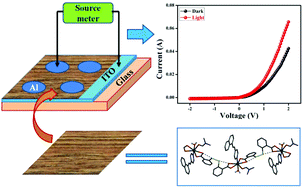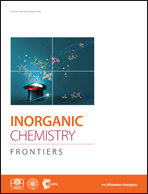Synthesis of a Cd(ii) based 1D coordination polymer by in situ ligand generation and fabrication of a photosensitive electronic device†
Abstract
A 2-mercaptobenzoic acid (2-mba) based zigzag one-dimensional coordination polymer (1D CP) [Cd(2,2′-dsb)(4-nvp)(DMF)(H2O)] (1) [H22,2′-dsb = 2,2′-disulfanediyldibenzoic acid (2,2′-dsba) and 4-nvp = 4-(1-naphthylvinyl)pyridine] has been synthesized by a slow diffusion technique and characterized by elemental analysis, infrared spectra, thermogravimetric analysis (TGA), powder X-ray diffraction (PXRD) pattern and single crystal X-ray diffraction (SCXRD) technique. The monomeric ligand 2-mba yields a dimeric 2,2′-dsb ligand via in situ S–S bond formation which leads to the formation of 1D CP. The flexibility of the structure is due to the S–S bond formation which impacts the electrical conductivity and photosensitivity of the compound. The 1D chains undergo gigantic molecular assembly via hydrogen bonding and C–H⋯π and π⋯π interactions to form a three-dimensional (3D) supramolecular architecture.

- This article is part of the themed collection: Inorganic Chemistry Frontiers HOT articles for 2018


 Please wait while we load your content...
Please wait while we load your content...